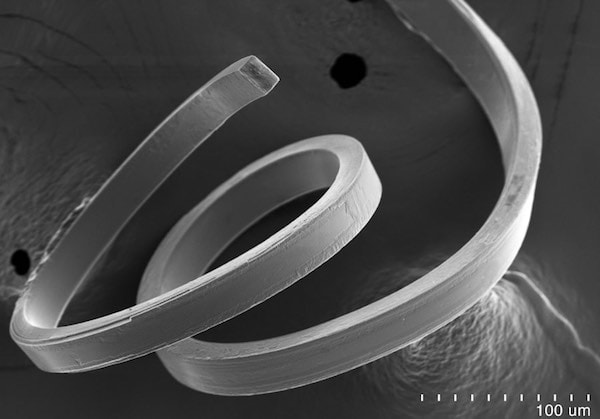
[Image above] Scanning electron microscopy image of flexible haloimidazole crystals. Credit: Seungbum Hong; Argonne National Laboratory
Ferroelectric materials are lauded for their ability to spontaneously polarize under strain, making these materials useful for capacitors that enable a whole host of applications. And we’ve learned a lot about these kinds of materials recently, including the fact that we’re still learning about the sometimes surprising properties of ferroelectric materials.
While many ferroelectric materials are ceramics, the one problem with ceramics is that they’re often brittle. But not always—researchers have previously shown that ceramics can become flexible by fashioning them into thin nanoribbons (composed of materials such as tin oxide, vanadium oxide coated in graphene, and more) that can bend without breaking.
Having flexible ferroelectrics would make this class of materials even more useful in next-gen applications. Flexible ferroelectrics could expand the materials’ reach into applications such as actuators for atomic force microscopy, ultrasonic imaging sensors, emitters for medical applications, and automobile sensors.
But are flexible ferroelectrics even possible?
In a word, yes.
Scientists at Argonne National Laboratory (Argonne, Ill.) in collaboration with researchers at Northwestern University (Evanston, Ill.) have discovered that some organic ferroelectric materials are composed of crystal planes that atomically slide past one another, providing them with flexibility.
But these new materials aren’t ceramic—they’re organic compounds called trisubstituted haloimidazoles.
“Ferroelectric materials are known for being quite brittle, and so it has always been a big challenge to make them mechanically flexible,” Argonne nanoscientist Seungbum Hong, who helped lead the research, says in an Argonne press release. “Because ferroelectricity and this kind of flexibility are relatively rare properties to see on their own—to have both ferroelectricity and flexibility in this new material is basically unprecedented.”
Recent research into ferroelectric materials is discovering all sorts of interesting and useful combinations of properties. In addition to these new ferroelectric materials that are also flexible, previous research has shown that ferroelectricity and ferromagnetism can coexist, too, in multiferroic materials.
In addition to a whole host of potential applications, there’s one other area of huge potential for flexible ferroelectrics: data storage.
“There’s a very large information density potential with ferroelectric storage,” Hong adds in the release. “This could make a big difference as we think about future generations of the data cloud.”
The open-access paper, published in Nature Communications, is “Flexible ferroelectric organic crystals” (DOI: 10.1038/ncomms13108).
Author
April Gocha
CTT Categories
- Basic Science
- Electronics
- Material Innovations
Related Posts
‘Fairy circles’ may help mark natural underground hydrogen deposits
September 18, 2025


